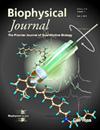基于动力学的蛋白质网络特征能准确区分中性位置和流变位置
IF 3.2
3区 生物学
Q2 BIOPHYSICS
引用次数: 0
摘要
在某些蛋白质中,有一类独特的非保留位置,其特点是能够通过单个氨基酸的置换产生不同的功能结果。由于它们能够调整蛋白质的功能,因此准确识别这类 "流变 "位置对于蛋白质设计、了解人类观察到的突变的影响以及预测病原体耐药性的进化至关重要。然而,确定 "流变调节器 "位置一直是一项挑战,部分原因是与结合位点缺乏明确的结构关系。在这项研究中,我们利用之前对大肠杆菌乳糖抑制蛋白(LacI)研究的实验数据,确定了突变可调节异位配体 "IPTG "体内EC50的流变位点。接下来,我们利用流变调节器的分配来验证一个假设,即流变调节器位置具有独特的动态特征,这将有助于识别它们。为此,我们将全原子分子动力学模拟与扰动残基响应分析相结合。结果首先揭示了 IPTG 结合的 LacI 与 apo LacI 不同的动态行为,这与 IPTG 作为异构诱导剂的作用是一致的。接下来,我们利用各种动态特征建立了一个分类模型,该模型可将 LacI 中具有实验特征的流变位置与具有其他类型取代结果的位置区分开来。与此同时,我们根据 LacI 的三维结构 "静态 "网络特征建立了第二个分类模型。在比较研究中,动态模型能更好地识别距离结合位点 8 Å 的流变位点。总之,我们的研究深入揭示了流变位置的动态特征,并表明基于动态特征建立的模型可能有助于预测各种蛋白质中流变位置的位置。本文章由计算机程序翻译,如有差异,请以英文原文为准。
Dynamics-based protein network features accurately discriminate neutral and rheostat positions
In some proteins, a unique class of nonconserved positions is characterized by their ability to generate diverse functional outcomes through single amino acid substitutions. Due to their ability to tune protein function, accurately identifying such “rheostat” positions is crucial for protein design, for understanding the impact of mutations observed in humans, and for predicting the evolution of pathogen drug resistance. However, identifying rheostat positions has been challenging, due—in part—to the absence of a clear structural relationship with binding sites. In this study, experimental data from our previous study of the Escherichia coli lactose repressor protein (LacI) was used to identify rheostat positions for which mutations tune in vivo EC50 for the allosteric ligand “IPTG.” We next used the rheostat assignments to test the hypothesis that rheostat positions have unique dynamic features that will enable their identification. To that end, we integrated all-atom molecular dynamics simulations with perturbation residue response analysis. Results first revealed distinct dynamic behavior in IPTG-bound LacI compared with apo LacI, which was consistent with IPTG’s role as an allosteric inducer. Next, we used a variety of dynamic features to build a classification model that discriminates experimentally characterized rheostat positions in LacI from positions with other types of substitution outcomes. In parallel, we built a second classifier model based on the 3D structural “static” network features of LacI. In comparative studies, the dynamic model better identified rheostat positions that were >8 Å from the binding site. In summary, our study provides insights into the dynamic characteristics of rheostat positions and suggests that models built on dynamic features may be useful for predicting the locations of rheostat positions in a wide range of proteins.
求助全文
通过发布文献求助,成功后即可免费获取论文全文。
去求助
来源期刊

Biophysical journal
生物-生物物理
CiteScore
6.10
自引率
5.90%
发文量
3090
审稿时长
2 months
期刊介绍:
BJ publishes original articles, letters, and perspectives on important problems in modern biophysics. The papers should be written so as to be of interest to a broad community of biophysicists. BJ welcomes experimental studies that employ quantitative physical approaches for the study of biological systems, including or spanning scales from molecule to whole organism. Experimental studies of a purely descriptive or phenomenological nature, with no theoretical or mechanistic underpinning, are not appropriate for publication in BJ. Theoretical studies should offer new insights into the understanding ofexperimental results or suggest new experimentally testable hypotheses. Articles reporting significant methodological or technological advances, which have potential to open new areas of biophysical investigation, are also suitable for publication in BJ. Papers describing improvements in accuracy or speed of existing methods or extra detail within methods described previously are not suitable for BJ.
 求助内容:
求助内容: 应助结果提醒方式:
应助结果提醒方式:


